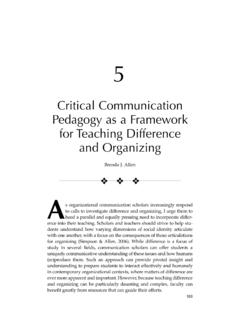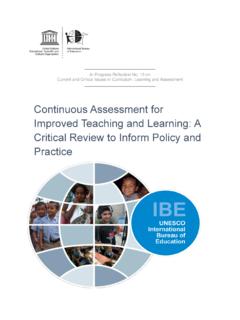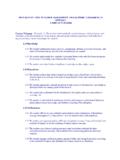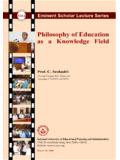Transcription of PISA 2015 COLLABORATIVE PROBLEM-SOLVING …
1 PISA 2015 COLLABORATIVE PROBLEM-SOLVING FRAMEWORK. JULY 2017. 1. TABLE OF CONTENTS. DEFINING THE DOMAIN ..6. COLLABORATIVE problem solving ..6. ORGANISATION OF THE COLLABORATIVE PROBLEM-SOLVING processes and factors affecting CPS ..9. PROBLEM-SOLVING skills ..9. COLLABORATIVE PROBLEM-SOLVING skills and competencies ..12. Overview of the domain ..13. Student background ..15. Context: problem scenarios, team composition, task characteristics and medium ..16. ASSESSING COLLABORATIVE PROBLEM-SOLVING Structure of the assessment ..18. Measurement of collaboration skills ..19. Conversational agents.
2 21. COLLABORATIVE PROBLEM-SOLVING task types ..23. Distribution of units and items ..24. Items and weighting for scoring ..25. Evidence-centred design ..26. Considerations for computer delivery ..27. Factors affecting item difficulty ..28. Considerations for contextual questionnaire ..28. Reporting proficiency in CPS ..29. SUMMARY ..31. GLOSSARY OF APPENDIX A. STUDIES ON CONVERSATIONAL AGENTS ..34. APPENDIX B. CPS LITERATURE REVIEW ..38. APPENDIX C: PISA 2015 COLLABORATIVE problem solving SAMPLE UNITS ..49. Purpose and scope of sample units ..49. Sample CPS unit: The Aquarium.
3 51. Sample CPS unit: Class Logo ..65. REFERENCES ..84. 2. COLLABORATIVE problem solving (CPS) is a critical and necessary skill used in education and in the workforce. While problem solving as defined in PISA 2012 (OECD, 2010) relates to individuals working alone on resolving problems where a method of solution is not immediately obvious, in CPS, individuals pool their understanding and effort and work together to solve these problems. Collaboration has distinct advantages over individual problem solving because it allows for: an effective division of labour the incorporation of information from multiple perspectives, experiences and sources of knowledge enhanced creativity and quality of solutions stimulated by the ideas of other group members.
4 1. Collaboration has been defined as a co-ordinated, synchronous activity that is the result of a continued attempt to construct and maintain a shared conception of a problem (Roschelle and Teasley, 1995, p. 70). Social interaction is a vital but insufficient condition for collaboration because some social interactions do not involve shared goals, accommodation of different perspectives or organised attempts to achieve the goals. 2. There is a growing emphasis in state and national education systems on project-based and inquiry-oriented learning (National Research Council, 2011a).
5 This includes shaping curriculum and instruction around critical thinking, problem solving , self-management and collaboration skills (Darling- Hammond, 2011; Halpern, 2003). Project-based work often includes tasks that require multiple students working together to achieve a team goal, such as a final report, integrated analyses or a joint presentation. COLLABORATIVE problem solving is not typically taught as an independent skill distinct from particular subjects. Therefore, in school-based contexts, COLLABORATIVE learning exercises are often integrated into specific courses of study, such as the sciences, mathematics and history.
6 3. Recent curriculum and instruction reforms have focused to a greater extent on the teaching and assessment of 21st century skills (Griffin et al., 2011; National Research Council, 2011a,b). These skills have included critical thinking, problem solving , self-management, information and communication technology (ICT) skills, communication and collaboration (Binkley at al., 2011; OECD, 2011). Collaboration and communication skills are central to this 21st-century skill set and are described in a number of 21st-century skills curricula and assessment reports. 4. For example, the focal point of Singapore's third IT Masterplan (2009-14) is to facilitate a greater level of technological integration in curriculum, assessment and pedagogy in order to equip students with critical competencies, such as self-directed learning and collaboration skills (Ministry of Education, Singapore, 2008).
7 Similarly, the Israeli national programme, Adapting the Educational System to the 21st Century (Ministry of Education, 2011), is a multiple-year plan with the goal of introducing innovative pedagogy in schools, including communication, collaboration, and other 21st-century skills. However, many of these curricula provide only a general framework and a description of goals and curriculum standards without defining the specific collaboration skills that are to be taught (Darling-Hammond, 2011). 5. Students need to prepare for careers that require the ability to work effectively in groups and to apply their PROBLEM-SOLVING skills in these social situations (Brannick and Prince, 1997; Griffin et al.)
8 , 2011; National Research Council, 2011a; Rosen and Rimor, 2012). There has been a marked shift from manufacturing to information and knowledge services. Much of the PROBLEM-SOLVING work carried out in the world today is performed by teams in an increasingly global and computerised economy. However, even in manufacturing, work is seldom conducted by individuals working alone. Moreover, with the greater availability of networked computers, individuals are increasingly expected to work with diverse 3. teams spread across different locations using COLLABORATIVE technology (Kanter, 1994; Salas, Cooke and Rosen, 2008).
9 6. The University of Phoenix Research Institute identified virtual collaboration, the ability to work productively, drive engagement, and demonstrate presence as a member of a virtual team (Davis, Fidler and Gorbis, 2011, p. 12), as one of ten key skills for the future workforce. A recent Forrester report, based on a survey of information and knowledge-management decision makers from 921 North American and European enterprises, revealed that 94% had implemented or were going to implement some form of collaboration technologies, including e-mail, web conferencing, team workspaces, instant messaging or videoconferencing (Enterprise and SMB Software Survey, North America and Europe, Q42009 Forrester report).
10 CPS skills are also needed in civic contexts, such as social networking, volunteering, participation in community life, and transactions with administration and public services. Thus, students emerging from schools into the workforce and public life will be expected to have COLLABORATIVE PROBLEM-SOLVING skills and the ability to collaborate using appropriate technology. 7. Collaboration among team members is crucial to the success of groups, families, corporations, public institutions, organisations and government agencies. One unco-operative member of a team can have serious negative consequences on team success.














